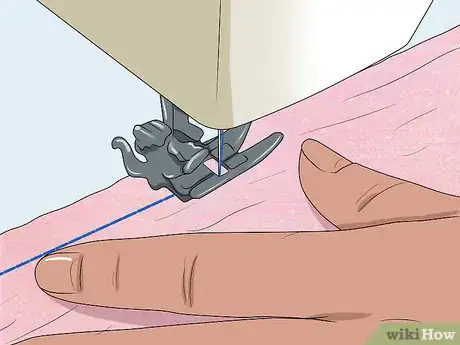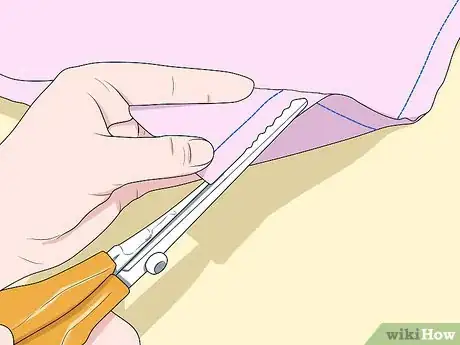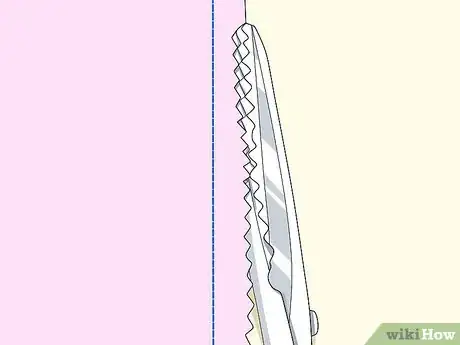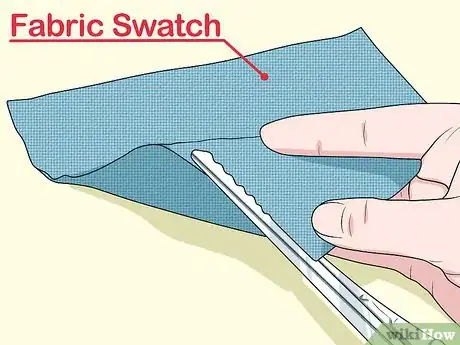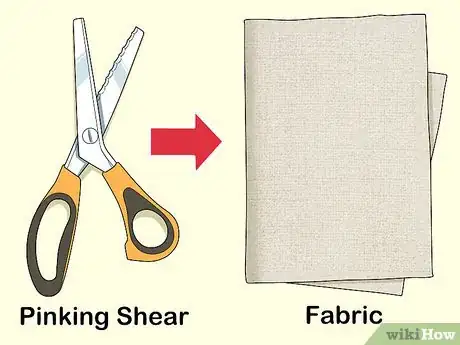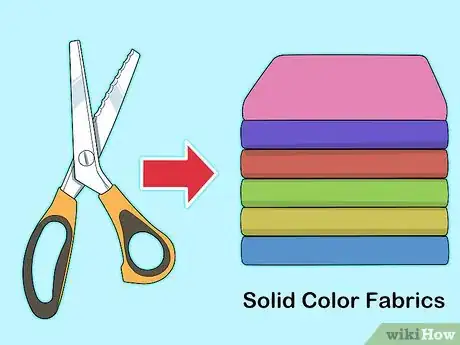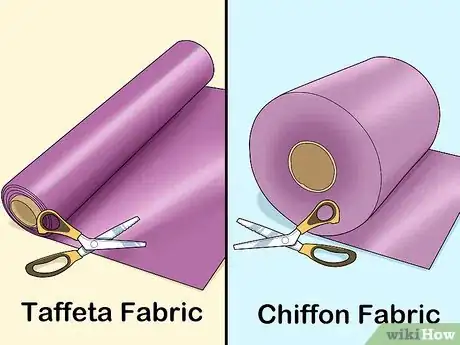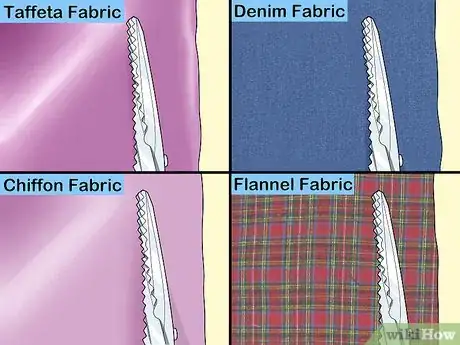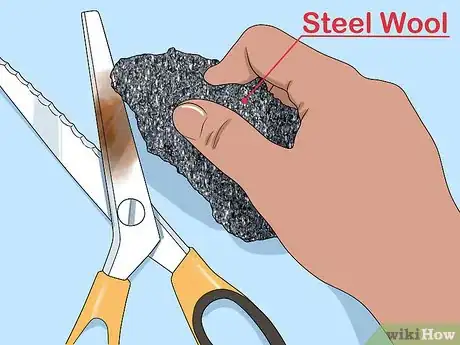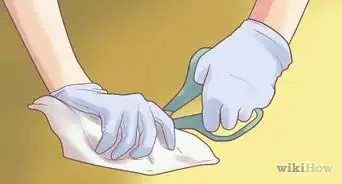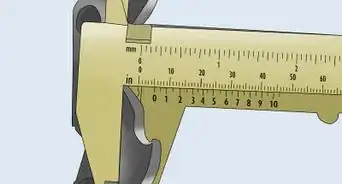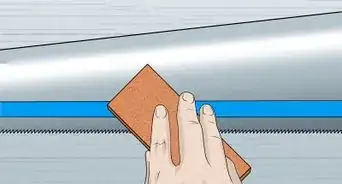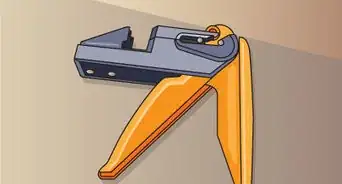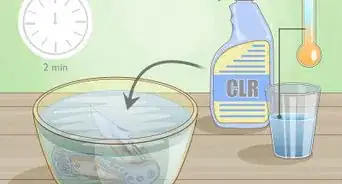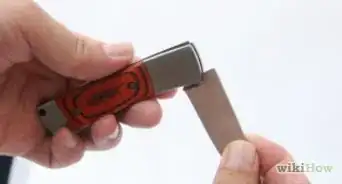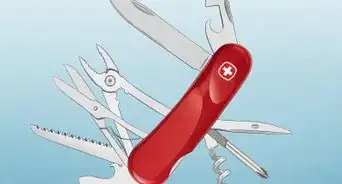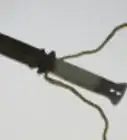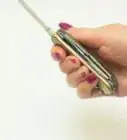This article was co-authored by wikiHow Staff. Our trained team of editors and researchers validate articles for accuracy and comprehensiveness. wikiHow's Content Management Team carefully monitors the work from our editorial staff to ensure that each article is backed by trusted research and meets our high quality standards.
There are 9 references cited in this article, which can be found at the bottom of the page.
This article has been viewed 94,104 times.
Learn more...
A nice, sharp pair of pinking shears can create a decorative hem after you've sewn a seam on your fabric. Choose a fabric that responds well to pinking shears, like woven materials or smooth fabrics. While you cut, cut carefully, and sharpen your shears often for a precise hem. Although the zig-zag design can be an appealing decoration, avoid using pinking shears on anything but fabric.
Steps
Cutting Fabric
-
1Sew your fabric's seam before you cut. Fabrics can only be pinked after the seam has been sewn. Depending on the fabric, you might use one of several seaming methods. You can use a sewing machine or hand-stitch the seam yourself.[1]
-
2Begin your cut along the edge of the seam. Don't take off too much of the fabric. Your fabric will fray least if it is as far from the seam itself as possible. While you can always cut off more if you're unsatisfied with the edge, you cannot put fabric back on after you've cut it.[2]Advertisement
-
3Cut the seam in a straight line. Pinked hems look neat and tidy when cut in a straight line. If you have trouble keeping your scissors steady, use a ruler to measure your cut as you go. Make your way carefully through the fabric's edge to avoid wavering lines.[3]
- Metal rulers are ideal for cutting in a straight line because they are harder to bend.
- You don't need to cut in a rush. Pink your fabric at your own pace.
-
4Practice on a fabric swatch first. If this is your first time using pinking shears, buy extra fabric to experiment with before you make the actual cuts. Try cutting in straight lines and at different paces to find what works best with you.
Choosing the Right Material
-
1Use pinking shears on fabrics only. Some specialized pinking shears are made for use on fabric as well as leather, paper, and other materials. In most cases, however, anything except fabric will dull your shears. To avoid having to sharpen your shears often, primarily cut fabric.[4]
-
2Pick pinking shears for fabrics with solid colors. Although you can use pinking shears on patterned fabrics, your project will not turn out as nicely. Look for fabrics in solid shades or very simple patterns. Your finished piece will look much more professional.
- Striped fabric looks especially poor when cut by pinking shears.
-
3Try pinking shears on smooth fabrics. Crisp fabrics (like taffeta or chiffon) look clean when cut by pinking shears. This is because the ridge left over by the shears is less thick and because the shears don't have to cut through too many layers. Bulky fabrics are usually harder to cut in a straight line.
-
4Cut primarily woven fabrics with pinking shears. Woven fabrics are those made by weaving threads over and under each other (hence the name). Tightly woven fabrics fray less and are best for pinking. Non-stretchy woven fabrics work particularly well if you want the cleanest cut.
- Examples of woven fabrics include: chiffon, denim, flannel, taffeta, crepe, kashmir silk, and chintz.[5]
Cleaning Pinking Shears
-
1Sharpen your pinking shears periodically. Dull pinking shears will make frayed cuts. When your shears are dull, use a sharpening wheel or sandpaper to maintain your shears. For routine maintenance, sharpen your scissors every four to six months.
- Do not use aluminum foil to sharpen pinking shears, as this method is ineffective on the jagged edges.[6]
-
2Cut wax paper with your shears. Pinking shears cut well with some lubrication. If your shears are sharpened but still fray your fabric, try cutting a few rows of wax paper. Wax residue will transfer to the shears and make your scissors less prone to sticking.[7]
-
3Oil your pinking shears. On occasions where cutting wax paper does not keep your shears lubricated enough, clean your scissors with oil. Open your scissors and place a few drops on the pivot between the blades. Open and close your scissors several times, then wipe off residual oil with a dry cloth.
-
4Keep an eye out for rust. Rusty pinking shears can make your fabric fray, even after cutting. If you spot any rust, rub it off vigorously using steel wool and dish soap. Dip your scissors in vinegar and scrub it clean, if your shears suffer from heavy rusting.[8]
- If neither steel wool nor vinegar works, use WD-40 to scrub your rusty shears.
- Do not store your pinking shears in wet or moist places.
Community Q&A
-
QuestionHow do I sharpen pinking shears?
 KillerkitanaCommunity AnswerUse your shears to cut a piece of aluminum foil a few times. The number of times is up to you, 3 or 4 should suffice. It is equivalent to striking a knife blade against a sharpening steel.
KillerkitanaCommunity AnswerUse your shears to cut a piece of aluminum foil a few times. The number of times is up to you, 3 or 4 should suffice. It is equivalent to striking a knife blade against a sharpening steel. -
QuestionWhen would you use pinking shears with a "wave", "serrated" and/or "scalloped" blade? I see there are buying options but no explanation which scissor cuts are used in specific fabric or effects.
 PhoebeAmelia24Community AnswerThese pinking shears produce a different looking edge, but in effect, they achieve the same thing. Just buy the shears that produce the edge you find the most desirable.
PhoebeAmelia24Community AnswerThese pinking shears produce a different looking edge, but in effect, they achieve the same thing. Just buy the shears that produce the edge you find the most desirable. -
QuestionMy pinking shears only cut at the handle end and not the tip. What should I do?
 The Randomness CornerCommunity AnswerGet a new pair of pinking shears. They are dulled out, and it is incredibly hard to sharpen them.
The Randomness CornerCommunity AnswerGet a new pair of pinking shears. They are dulled out, and it is incredibly hard to sharpen them.
Things You'll Need
- Pinking shears
- Fabric
- Sewing machine (or needle and thread)
- Metal ruler
- Sharpening wheel
- Sandpaper
- Wax paper
- Machine oil
- Cloth
- Steel wool
- Dish soap
- Vinegar
- WD-40
References
- ↑ https://www.seasonedhomemaker.com/finish-seams-without-a-serger/
- ↑ https://www.youtube.com/watch?v=Uhm-2qyCp3M
- ↑ https://www.craftsy.com/blog/2013/05/seam-series-serger-and-pinking-seam-finishing/
- ↑ https://oliverands.com/community/blog/2010/06/pinking-finished-seams.html
- ↑ http://www.textileschool.com/articles/375/woven-fabrics
- ↑ http://www.threadsmagazine.com/item/66215/qa-sharpen-pinking-shears
- ↑ https://www.youtube.com/watch?v=FCC6Kh4nn4g
- ↑ https://www.hunker.com/13420830/how-to-clean-rust-off-scissors
- ↑ https://inmyownstyle.com/2016/07/no-sew-decorating-ideas-how-to-decorate-with-fabric-without-sewing-a-stitch.html
